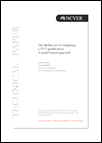Description
One of the distinctive characteristics of the VET sector is that many students wish to learn specific skills and have no intention of completing a full qualification. This paper estimates the completion rate of VET course enrolments with a mathematical modelling approach in order to fill a gap in performance measures for the sector.
Summary
About the research
This paper estimates vocational education and training (VET) course-completion rates, in order to fill a gap in performance measures for the VET sector.
The technique we use is to track all VET course enrolments within a three-year window, centred on the year of interest. Then, using an absorbing Markov chain model for a VET course enrolment, we estimate the proportion of VET course enrolments commencing in the year of interest that will eventually be completed. This approach allows us to estimate the completion rate without having to longitudinally track course enrolments over a long period of time.
Key messages
- The national estimated completion rate of VET course enrolments at certificate I level or above commencing in 2005 is 27.1%. For full-time VET students aged 25 years and under in 2005, this rate is 34.7%.
-
When cut by fields of education, the completion rates in 2005 range from 13.3% (for course
enrolments in Mixed field programs) to 48.3% (for course enrolments in Education). -
Course enrolments at certificate III level had the highest rate of completion at 33.5%
compared with other qualification levels.
One of the distinctive characteristics of the VET sector is that many students wish to learn specific skills and have no intention of completing a full qualification. For these students a more sensible measure of success is the proportion of modules passed (the load pass rate). Overall, the load pass rate of 2005 enrolments was 79.1%. NCVER is conducting a survey of student intentions in 2010–11, with a view to establishing the groups of students for which the qualification completion rate is an appropriate performance indicator.
Tom Karmel
Managing Director, NCVER
